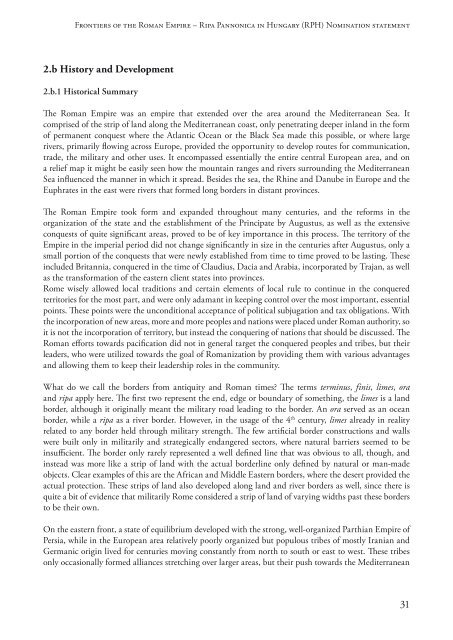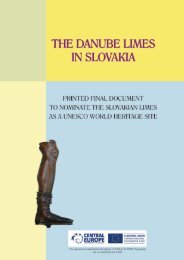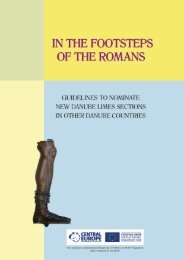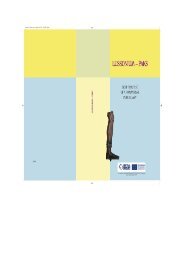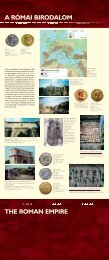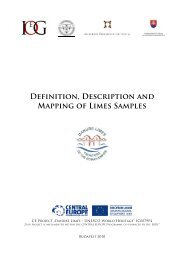the PDF version! - Danube Limes
the PDF version! - Danube Limes
the PDF version! - Danube Limes
You also want an ePaper? Increase the reach of your titles
YUMPU automatically turns print PDFs into web optimized ePapers that Google loves.
Frontiers of <strong>the</strong> Roman Empire – Ripa Pannonica in Hungary (RPH) Nomination statement<br />
2.b History and Development<br />
2.b.1 Historical Summary<br />
The Roman Empire was an empire that extended over <strong>the</strong> area around <strong>the</strong> Mediterranean Sea. It<br />
comprised of <strong>the</strong> strip of land along <strong>the</strong> Mediterranean coast, only penetrating deeper inland in <strong>the</strong> form<br />
of permanent conquest where <strong>the</strong> Atlantic Ocean or <strong>the</strong> Black Sea made this possible, or where large<br />
rivers, primarily flowing across Europe, provided <strong>the</strong> opportunity to develop routes for communication,<br />
trade, <strong>the</strong> military and o<strong>the</strong>r uses. It encompassed essentially <strong>the</strong> entire central European area, and on<br />
a relief map it might be easily seen how <strong>the</strong> mountain ranges and rivers surrounding <strong>the</strong> Mediterranean<br />
Sea influenced <strong>the</strong> manner in which it spread. Besides <strong>the</strong> sea, <strong>the</strong> Rhine and <strong>Danube</strong> in Europe and <strong>the</strong><br />
Euphrates in <strong>the</strong> east were rivers that formed long borders in distant provinces.<br />
The Roman Empire took form and expanded throughout many centuries, and <strong>the</strong> reforms in <strong>the</strong><br />
organization of <strong>the</strong> state and <strong>the</strong> establishment of <strong>the</strong> Principate by Augustus, as well as <strong>the</strong> extensive<br />
conquests of quite significant areas, proved to be of key importance in this process. The territory of <strong>the</strong><br />
Empire in <strong>the</strong> imperial period did not change significantly in size in <strong>the</strong> centuries after Augustus, only a<br />
small portion of <strong>the</strong> conquests that were newly established from time to time proved to be lasting. These<br />
included Britannia, conquered in <strong>the</strong> time of Claudius, Dacia and Arabia, incorporated by Trajan, as well<br />
as <strong>the</strong> transformation of <strong>the</strong> eastern client states into provinces.<br />
Rome wisely allowed local traditions and certain elements of local rule to continue in <strong>the</strong> conquered<br />
territories for <strong>the</strong> most part, and were only adamant in keeping control over <strong>the</strong> most important, essential<br />
points. These points were <strong>the</strong> unconditional acceptance of political subjugation and tax obligations. With<br />
<strong>the</strong> incorporation of new areas, more and more peoples and nations were placed under Roman authority, so<br />
it is not <strong>the</strong> incorporation of territory, but instead <strong>the</strong> conquering of nations that should be discussed. The<br />
Roman efforts towards pacification did not in general target <strong>the</strong> conquered peoples and tribes, but <strong>the</strong>ir<br />
leaders, who were utilized towards <strong>the</strong> goal of Romanization by providing <strong>the</strong>m with various advantages<br />
and allowing <strong>the</strong>m to keep <strong>the</strong>ir leadership roles in <strong>the</strong> community.<br />
What do we call <strong>the</strong> borders from antiquity and Roman times? The terms terminus, finis, limes, ora<br />
and ripa apply here. The first two represent <strong>the</strong> end, edge or boundary of something, <strong>the</strong> limes is a land<br />
border, although it originally meant <strong>the</strong> military road leading to <strong>the</strong> border. An ora served as an ocean<br />
border, while a ripa as a river border. However, in <strong>the</strong> usage of <strong>the</strong> 4 th century, limes already in reality<br />
related to any border held through military strength. The few artificial border constructions and walls<br />
were built only in militarily and strategically endangered sectors, where natural barriers seemed to be<br />
insufficient. The border only rarely represented a well defined line that was obvious to all, though, and<br />
instead was more like a strip of land with <strong>the</strong> actual borderline only defined by natural or man-made<br />
objects. Clear examples of this are <strong>the</strong> African and Middle Eastern borders, where <strong>the</strong> desert provided <strong>the</strong><br />
actual protection. These strips of land also developed along land and river borders as well, since <strong>the</strong>re is<br />
quite a bit of evidence that militarily Rome considered a strip of land of varying widths past <strong>the</strong>se borders<br />
to be <strong>the</strong>ir own.<br />
On <strong>the</strong> eastern front, a state of equilibrium developed with <strong>the</strong> strong, well-organized Parthian Empire of<br />
Persia, while in <strong>the</strong> European area relatively poorly organized but populous tribes of mostly Iranian and<br />
Germanic origin lived for centuries moving constantly from north to south or east to west. These tribes<br />
only occasionally formed alliances stretching over larger areas, but <strong>the</strong>ir push towards <strong>the</strong> Mediterranean<br />
31


